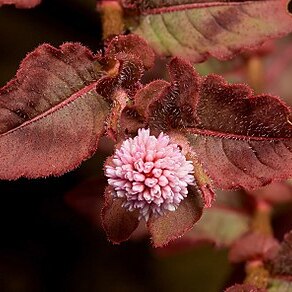Herbs, perennial or annual (sometimes suffrutescent in P. wallichii); taprooted or fibrous-rooted; sometimes rhizomatous or stoloniferous. Stems erect or, sometimes, prostrate or scandent, simple or branched, glabrous or pubescent, rarely with recurved prickles. Leaves deciduous, mostly cauline, alternate, petiolate or sessile; ocrea persistent or disintegrating with age and deciduous entirely or distally, usually tan, brown, or reddish, chartaceous or partially to entirely foliaceous, rarely coriaceous proximally and chartaceous distally, glabrous or scabrous to variously pubescent, never 2-lobed distally; blade lanceolate or ovate to hastate or sagittate, margins entire or, rarely, hastately lobed. Inflorescences terminal or terminal and axillary, spikelike, paniclelike, or capitate; peduncle present. Pedicels present or absent. Flowers bisexual (often functionally unisexual in P. amphibia and P. hydropiperoides), 1-14 per ocreate fascicle, base not stipelike; perianth white, greenish white, roseate, red, or purple, campanulate or urceolate, rarely rotate, rarely becoming fleshy in fruit, glabrous, sometimes glandular-punctate, accrescent or nonaccrescent; tepals 4-5, connate 1/ 2/ 3 their lengths (less than 5 their lengths in P. wallichii), petaloid, dimorphic, outer larger than inner; stamens 5-8, filaments distinct or connate basally, outer ones sometimes adnate to perianth tube, glabrous; anthers yellow, pink, or red, elliptic to ovate; styles 2-3, erect to spreading or reflexed, distinct or connate; stigmas capitate. Achenes included or exserted, brown or dark brown to black, not winged, discoid, biconvex, 2-3-gonous, or spheroidal, glabrous. Seeds: embryo curved. x = 10, 11, 12.
More
Perianth segments (4)5, equal or somewhat unequal in length, spirally arranged, often imbricate, free or united at the base, petaloid at least in part, with a trifid venation (the main vein flanked by 2 collateral veins arising near the base); outer segments similar to the inner.
Stamens 5–8, rarely fewer, included or not; filaments uniformly subulate or filiform, free or sometimes united at the base into a ring, but without interstaminal nectaries; anthers globose or ellipsoid, dorsifixed.
Flowers hermaphrodite, rarely unisexual, in pedunculate terminal or axillary racemes, spikes, panicles or heads; bracteoles 2, fused, thinly membranous and contained within the bracts.
Ocrea membranaceous, pale brown, reddish or hyaline, entire, often tubular, glabrous or hairy, often fringed with cilia.
Nut lenticular or trigonous, enclosed in the persistent perianth or protruding from it for less than half its length.
Annual or perennial erect or occasionally prostrate herbs (rarely shrubs), glabrous or hairy, often glandular.
Ovary included within the perianth; styles 2(3), united at the base or rarely free; stigmas capitate.
Leaves alternate, very variable in shape, always distinctly longer than wide.
Stems often conspicuously swollen at the nodes.
